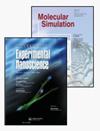海水淡化中纳米孔离子传输的调制:分子动力学研究
IF 2
4区 化学
Q4 CHEMISTRY, PHYSICAL
引用次数: 0
摘要
深入了解离子在纳米孔中的传输机制是开发先进海水淡化技术的一个重要问题。通过设计四种基于碳纳米材料的纳米膜,采用分子动力学模拟方法系统研究了海水淡化过程中离子通过纳米孔的平移动力学。结果表明:圆形孔隙具有较好的透水性,而狭缝孔隙由于孔隙面积较大,阻力较小;纳米通道膜增加了离子的停留时间。氟化诱导了更有序的离子水合结构,并增强了Na + - cl离子对的结合。-OH基团取代部分离子水合水分子,促进离子进入膜。- nh3 +、- coo -基团对带相反电荷的离子具有较强的吸附作用,大大减缓了离子动力学。纳米通道内部的功能化可以进一步增强界面摩擦和运输阻力,甚至导致带电基团堵塞孔。氟化纳米通道膜完全排斥离子,水渗透系数为1.88 × 104 L·m−2·h−1·bar−1,打破了渗透-选择性权衡。该研究表明,离子在纳米孔中的传输可以被精细调节,以获得更高的海水淡化性能。秦兰兰:方法学、软件、验证、形式分析、调查、数据管理、原创文稿写作、可视化和资金获取。黄海鸥:资源与写作——评审与编辑。周健:概念、资源、撰稿编辑、监督、项目管理、资金获取。披露声明作者未报告潜在的利益冲突。数据可得性声明支持本研究结果的数据可根据通讯作者的合理要求获得。本工作得到广州市基础与应用基础研究基金(2023A04J1363)、广东省基础与应用基础研究基金(2022A1515010876)和国家自然科学基金(22378134)的资助。本文章由计算机程序翻译,如有差异,请以英文原文为准。
Modulation of ion transport through nanopores in water desalination: a molecular dynamics study
ABSTRACTA good understanding of ion transport mechanisms through nanopores is an important issue for the development of advanced water desalination technologies. We use the molecular dynamics simulation method to systematically investigate the translation dynamics of ions through nanopores in the water desalination process by designing four kinds of nano-membranes based on carbon nanomaterials. Results indicate that circular-shaped pore exhibits better water permeability, nevertheless, the slit pore has a lower resistance due to the larger pore area; nanochannel membranes increase the residence time of ions. Fluorination induces more ordered ionic hydration structures, and enhances Na + -Cl- ion pair association. -OH groups replace partial ionic hydration water molecules and facilitate ions transport into membranes. The -NH3+, -COO- groups can strongly adsorb the oppositely charged ions, and substantially slow down ion dynamics. Functionalisation within nanochannel interior can further enhance interfacial friction and transport resistance, even causing pore blocking by charged groups. The fluorinated nanochannel membrane demonstrates complete rejection of ions with a water permeability coefficient of 1.88 × 104 L·m−2·h−1·bar−1, breaking the permeability-selectivity trade-off. This study indicates that ion transport in nanopores could be finely modulated to obtain enhanced performance in water desalination.KEYWORDS: Ion transportnanoporemolecular dynamics simulationwater desalinationnano-membrane AcknowledgementsLanlan Qin: Methodology, software, validation, formal analysis, investigation, data curation, writing – original draft, visualization and funding acquisition. Haiou Huang: Resources and writing – review and editing. Jian Zhou: Conceptualization, resources, writing – review and editing, supervision, project administration and funding acquisition.Disclosure statementNo potential conflict of interest was reported by the authors.Data availability statementThe data that support the findings of this study are available from the corresponding author upon reasonable request.Additional informationFundingThis work was supported by the Guangzhou Basic and Applied Basic Research Foundation (2023A04J1363), the GuangDong Basic and Applied Basic Research Foundation (2022A1515010876) and the National Natural Science Foundation of China (No. 22378134).
求助全文
通过发布文献求助,成功后即可免费获取论文全文。
去求助
来源期刊

Molecular Simulation
化学-物理:原子、分子和化学物理
CiteScore
3.80
自引率
9.50%
发文量
128
审稿时长
3.1 months
期刊介绍:
Molecular Simulation covers all aspects of research related to, or of importance to, molecular modelling and simulation.
Molecular Simulation brings together the most significant papers concerned with applications of simulation methods, and original contributions to the development of simulation methodology from biology, biochemistry, chemistry, engineering, materials science, medicine and physics.
The aim is to provide a forum in which cross fertilization between application areas, methodologies, disciplines, as well as academic and industrial researchers can take place and new developments can be encouraged.
Molecular Simulation is of interest to all researchers using or developing simulation methods based on statistical mechanics/quantum mechanics. This includes molecular dynamics (MD, AIMD), Monte Carlo, ab initio methods related to simulation, multiscale and coarse graining methods.
 求助内容:
求助内容: 应助结果提醒方式:
应助结果提醒方式:


